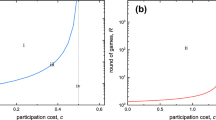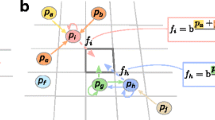Abstract
We investigate the evolution of public goods cooperation in a metapopulation model with small local populations, where altruistic cooperation can evolve due to assortment and kin selection, and the evolutionary emergence of cooperators and defectors via evolutionary branching is possible. Although evolutionary branching of cooperation has recently been demonstrated in the continuous snowdrift game and in another model of public goods cooperation, the required conditions on the cost and benefit functions are rather restrictive, e.g., altruistic cooperation cannot evolve in a defector population. We also observe selection for too low cooperation, such that the whole metapopulation goes extinct and evolutionary suicide occurs. We observed intuitive effects of various parameters on the numerical value of the monomorphic singular strategy. Their effect on the final coexisting cooperator–defector pair is more complex: changes expected to increase cooperation decrease the strategy value of the cooperator. However, at the same time the population size of the cooperator increases enough such that the average strategy does increase. We also extend the theory of structured metapopulation models by presenting a method to calculate the fitness gradient in a general class of metapopulation models, and try to make a connection with the kin selection approach.
Similar content being viewed by others
References
Alizon, S., & Taylor, P. (2008). Empty sites can promote altruistic behavior. Evolution, 62, 1335–1344.
Allee, W. C., Emerson, A., Park, T., & Schmidt, K. (1949). Principles of animal ecology. Philadelphia: Saunders.
Brännström, Å., & Dieckmann, U. (2005). Evolutionary dynamics of altruism and cheating among social amoebas. Proc. R. Soc. Lond. B, 272, 1609–1616.
Doebeli, M., Hauert, C., & Killingback, T. (2004). The evolutionary origin of cooperators and defectors. Science, 306, 859–862.
Doebeli, M., & Ruxton, G. D. (1997). Evolution of dispersal rates in metapopulation models: branching and cyclic dynamics in phenotype space. Evolution, 51, 1730–1741.
Eshel, I. (1983). Evolutionary and continuous stability. J. Theor. Biol., 103, 99–111.
Faddeev, D. K., & Faddeeva, V. N. (1963). Computational methods of linear algebra. San Francisco: Freeman.
Ferrière, R. (2000). Adaptive responses to environmental threats: evolutionary suicide, insurance, and rescue. In Options, Spring 2000 (pp. 12–16). Laxenburg: IIASA.
Geritz, S. A. H., Kisdi, É., Meszéna, G., & Metz, J. A. J. (1998). Evolutionarily singular strategies and the adaptive growth and branching of the evolutionary tree. Evol. Ecol., 12, 35–57.
Geritz, S. A. H., Metz, J. A. J., Kisdi, É., & Meszéna, G. (1997). Dynamics of adaptation and evolutionary branching. Phys. Rev. Lett., 78, 2024–2027.
Geritz, S. A. H., van der Meijden, E., & Metz, J. A. J. (1999). Evolutionary dynamics of seed size and seedling competitive ability. Theor. Popul. Biol., 55, 324–343.
Grafen, A. (1985). A geometric view of relatedness. Oxf. Surv. Evol. Biol., 2, 28–89.
Griffin, A., West, S., & Buckling, A. (2004). Cooperation and competition in pathogenic bacteria. Nature, 430, 1024–1027.
Gyllenberg, M., & Metz, J. A. J. (2001). On fitness in structured metapopulations. J. Math. Biol., 43, 545–560.
Gyllenberg, M., & Parvinen, K. (2001). Necessary and sufficient conditions for evolutionary suicide. Bull. Math. Biol., 63, 981–993.
Gyllenberg, M., Parvinen, K., & Dieckmann, U. (2002). Evolutionary suicide and evolution of dispersal in structured metapopulations. J. Math. Biol., 45, 79–105.
Hamilton, W. D. (1964a). The genetical evolution of social behaviour i. J. Theor. Biol., 7, 1–16.
Hamilton, W. D. (1964b). The genetical evolution of social behaviour ii. J. Theor. Biol., 7, 17–52.
Hardin, G. (1968). The tragedy of the commons. Science, 162, 1243–1248.
Harrison, F., & Buckling, A. (2009). Cooperative production of siderophores by Pseudomonas aeruginosa. Front. Biosci., 14, 4113–4126.
Hauert, C. (2006). Cooperation, collectives formation and specialization. Adv. Complex Syst., 9, 315–335.
Hauert, C., Holmes, M., & Doebeli, M. (2006). Evolutionary games and population dynamics: maintenance of cooperation in public goods games. Proc. R. Soc. Lond. B, 273, 2565–2570.
Hauert, C., Traulsen, A., Brandt, H., Nowak, M. A., & Sigmund, K. (2007). Via freedom to coercion: the emergence of costly punishment. Science, 316, 1905–1907.
Jansen, V. A. A., & van Baalen, M. (2006). Altruism through beard chromodynamics. Nature, 440, 663–666.
Kemeny, J. G., & Snell, J. (1960). Finite Markov chains. Princeton: Van Nostrand.
Kuemmerli, R., Griffin, A. S., West, S. A., Buckling, A., & Harrison, F. (2009). Viscous medium promotes cooperation in the pathogenic bacterium Pseudomonas aeruginosa. Proc. R. Soc. Lond. B, 276, 3531–3538.
Le Galliard, J.-F., Ferriére, R., & Dieckmann, U. (2003). The adaptive dynamics of altruism in spatially heterogeneous populations. Evolution, 57, 1–17.
Levins, R. (1969). Some demographic and genetic consequenses of environmental heterogeneity for biological control. Bull. Entomol. Soc. Am., 15, 237–240.
Levins, R. (1970). Extinction. In M. Gerstenhaber (Ed.), Some mathematical problems in biology (pp. 77–107). Providence: American Mathematical Society.
Mathias, A., Kisdi, É., & Olivieri, I. (2001). Divergent evolution of dispersal in a heterogeneous landscape. Evolution, 55, 246–259.
Matsuda, H. (1985). Evolutionarily stable strategies for predator switching. J. Theor. Biol., 115, 351–366.
Matsuda, H., & Abrams, P. A. (1994). Timid consumers: self-extinction due to adaptive change in foraging and anti-predator effort. Theor. Popul. Biol., 45, 76–91.
Maynard Smith, J. (1976). Evolution and the theory of games. Am. Sci., 64, 41–45.
Metz, J. A. J., Geritz, S. A. H., Meszéna, G., Jacobs, F. J. A., & van Heerwaarden, J. S. (1996). Adaptive dynamics, a geometrical study of the consequenses of nearly faithful reproduction. In S. J. van Strien & S. M. Verduyn Lunel (Eds.), Stochastic and spatial structures of dynamical systems (pp. 183–231). Amsterdam: North-Holland.
Metz, J. A. J., & Gyllenberg, M. (2001). How should we define fitness in structured metapopulation models? Including an application to the calculation of ES dispersal strategies. Proc. R. Soc. Lond. B, 268, 499–508.
Metz, J. A. J., Nisbet, R. M., & Geritz, S. A. H. (1992). How should we define “fitness” for general ecological scenarios? Trends Ecol. Evol., 7, 198–202.
Nowak, M. A., & Sigmund, K. (2005). Evolution of indirect reciprocity. Nature, 437, 1291–1298.
Nurmi, T., & Parvinen, K. (2008). On the evolution of specialization with a mechanistic underpinning in structured metapopulations. Theor. Popul. Biol., 73, 222–243.
Nurmi, T., & Parvinen, K. (2011). Joint evolution of specialization and dispersal in structured metapopulations. J. Theor. Biol., 275, 78–92. doi:10.1016/j.jtbi.2011.01.023.
Ohtsuki, H., & Iwasa, Y. (2006). The leading eight: social norms that can maintain cooperation by indirect reciprocity. J. Theor. Biol., 239, 435–444.
Parvinen, K. (1999). Evolution of migration in a metapopulation. Bull. Math. Biol., 61, 531–550.
Parvinen, K. (2002). Evolutionary branching of dispersal strategies in structured metapopulations. J. Math. Biol., 45, 106–124.
Parvinen, K. (2005). Evolutionary suicide. Acta Biotheor., 53, 241–264.
Parvinen, K. (2006). Evolution of dispersal in a structured metapopulation model in discrete time. Bull. Math. Biol., 68, 655–678.
Parvinen, K. (2007). Evolutionary suicide in a discrete-time metapopulation model. Evol. Ecol. Res., 9, 619–633.
Parvinen, K. (2010). Adaptive dynamics of cooperation may prevent the coexistence of defectors and cooperators and even cause extinction. Proc. R. Soc. Lond. B, 277, 2493–2501.
Parvinen, K., Dieckmann, U., Gyllenberg, M., & Metz, J. A. J. (2003). Evolution of dispersal in metapopulations with local density dependence and demographic stochasticity. J. Evol. Biol., 16, 143–153.
Parvinen, K., & Egas, M. (2004). Dispersal and the evolution of specialisation in a two-habitat type metapopulation. Theor. Popul. Biol., 66, 233–248.
Parvinen, K., & Metz, J. A. J. (2008). A novel fitness proxy in structured locally finite metapopulations with diploid genetics, with an application to dispersal evolution. Theor. Popul. Biol., 73, 517–528.
Queller, D. C. (1994). Genetic relatedness in viscous populations. Evol. Ecol., 8, 70–73.
Racey, D., Inglis, R. F., Harrison, F., Oliver, A., & Buckling, A. (2010). The effect of elevated mutation rates on the evolution of cooperation and virulence of Pseudomonas aeruginosa. Evolution, 64, 515–521.
Rankin, D. J., & López-Sepulcre, A. (2005). Can adaptation lead to extinction? Oikos, 111, 616–619.
Ross-Gillespie, A., Gardner, A., Buckling, A., West, S. A., & Griffin, A. S. (2009). Density dependence and cooperation: theory and a test with bacteria. Evolution, 63, 2315–2325.
Taylor, P. D. (1992). Altruism in viscous populations—an inclusive fitness model. Evol. Ecol., 6, 352–356.
Van Tienderen, P. H., & De Jong, G. (1986). Sex ratio under the haystack model: Polymorphism may occur. J. Theor. Biol., 122, 69–81.
Webb, C. (2003). A complete classification of Darwinian extinction in ecological interactions. Am. Nat., 161, 181–205.
West, S. A., Griffin, A. S., & Gardner, A. (2008). Social semantics: how useful has group selection been? J. Evol. Biol., 21, 374–385.
Author information
Authors and Affiliations
Corresponding author
Rights and permissions
About this article
Cite this article
Parvinen, K. Adaptive Dynamics of Altruistic Cooperation in a Metapopulation: Evolutionary Emergence of Cooperators and Defectors or Evolutionary Suicide?. Bull Math Biol 73, 2605–2626 (2011). https://doi.org/10.1007/s11538-011-9638-4
Received:
Accepted:
Published:
Issue Date:
DOI: https://doi.org/10.1007/s11538-011-9638-4




